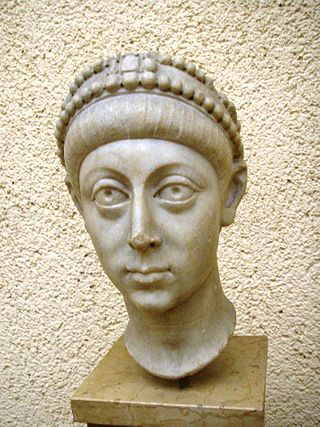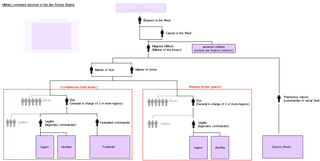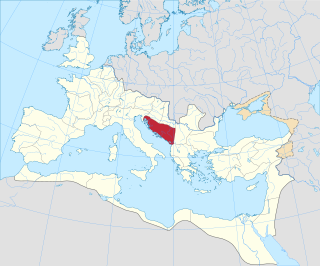
Arcadius was Roman emperor from 383 to his death in 408. He was the eldest son of the Augustus Theodosius I and his first wife Aelia Flaccilla, and the brother of Honorius. Arcadius ruled the eastern half of the empire from 395, when their father died, while Honorius ruled the west. In his time, he was seen as a weak ruler dominated by a series of powerful ministers and by his wife, Aelia Eudoxia.

The Gallic Empire or the Gallic Roman Empire are names used in modern historiography for a breakaway part of the Roman Empire that functioned de facto as a separate state from 260 to 274. It originated during the Crisis of the Third Century, when a series of Roman military leaders and aristocrats declared themselves emperors and took control of Gaul and adjacent provinces without attempting to conquer Italy or otherwise seize the central Roman administrative apparatus.

The Praetorian Guard was an elite unit of the Imperial Roman army that served as personal bodyguards and intelligence agents for the Roman emperors.

Magister militum was a top-level military command used in the late Roman Empire, dating from the reign of Constantine the Great. The term referred to the senior military officer of the empire. In Greek sources, the term is translated either as strategos or as stratelates.
The praetorian prefect was a high office in the Roman Empire. Originating as the commander of the Praetorian Guard, the office gradually acquired extensive legal and administrative functions, with its holders becoming the Emperor's chief aides. Under Constantine I, the office was much reduced in power and transformed into a purely civilian administrative post, while under his successors, territorially-defined praetorian prefectures emerged as the highest-level administrative division of the Empire. The prefects again functioned as the chief ministers of the state, with many laws addressed to them by name. In this role, praetorian prefects continued to be appointed by the Eastern Roman Empire until the reign of Heraclius in the 7th century AD, when wide-ranging reforms reduced their power and converted them to mere overseers of provincial administration. The last traces of the prefecture disappeared in the Byzantine Empire by the 840s.

The praetorian prefecture of Illyricum was one of four praetorian prefectures into which the Late Roman Empire was divided.
The praetorian prefecture was the largest administrative division of the late Roman Empire, above the mid-level dioceses and the low-level provinces. Praetorian prefectures originated in the reign of Constantine I, reaching their more or less final form in the last third of the 4th century and surviving until the 7th century, when the reforms of Heraclius diminished the prefecture's power, and the Muslim conquests forced the Eastern Roman Empire to adopt the new theme system. Elements of the prefecture's administrative apparatus, however, are documented to have survived in the Byzantine Empire until the first half of the 9th century.

Anthemius was a statesman of the Later Roman Empire. He is notable as a praetorian prefect of the East in the later reign of Arcadius and the first years of Theodosius II, during which time he led the government of the Eastern Roman Empire on behalf of the child emperor and supervised the construction of the first set of the Theodosian Walls.
The magister officiorum was one of the most senior administrative officials in the Later Roman Empire and the early centuries of the Byzantine Empire. In Byzantium, the office was eventually transformed into a senior honorary rank, simply called magistros (μάγιστρος), until it disappeared in the 12th century.

The praetorian prefecture of Italy was one of four praetorian prefectures into which the Late Roman Empire was divided. It comprised the Italian peninsula, the western Balkans, the Danubian provinces and parts of North Africa. The Prefecture's seat moved from Rome to Milan and finally, Ravenna.

Dalmatia was a Roman province. Its name is derived from the name of an Illyrian tribe called the Dalmatae, which lived in the central area of the eastern coast of the Adriatic Sea. It encompassed the northern part of present-day Albania, much of Croatia, Bosnia and Herzegovina, Montenegro,and Serbia, thus covering an area significantly larger than the current Croatian and Montenegrin region of Dalmatia. Originally this region was called Illyria or Illyricum.

The Praetorian Prefecture of Gaul was one of four large prefectures into which the Late Roman Empire was divided.
The praepositus sacri cubiculi was one of the senior palace offices in the Late Roman Empire. Its holder was usually a eunuch, and acted as the grand chamberlain of the palace, wielding considerable authority and influence. In the 7th or 8th century, the title was also given to an order of rank for eunuch palace servants. The title and office continued in use in the simplified form of praipositos (πραιπόσιτος) in the Byzantine Empire until the late 11th century.
Flavius Monaxius was a politician of the Eastern Roman Empire, praefectus urbi of Constantinople, Consul and twice praetorian prefect of the East.
Flavius Avitus Marinianus was a politician of the Western Roman Empire during the reign of Honorius.
Flavius Anicius Auchenius Bassus was a high official of the Western Roman Empire. He was appointed as consul by the Western court with Antiochus Chuzon as a colleague. In 435 he held for the second time the office of praetorian prefect of Italy.
Junius Quartus Palladius was a politician of the Western Roman Empire, who held the Praetorian prefecture of Italy, Illyricum and Africa for six years and was also consul in 416.
Afranius Hannibalianus was the consul of 292 AD, a praetorian prefect, a senator and a military officer and commander.

The Eastern Roman Empire was ruled by the Theodosian dynasty from 379, the accession of Theodosius I, to 457, the death of Marcian. The rule of the Theodosian dynasty saw the final East-West division of the Roman Empire, between Arcadius and Honorius in 395. Whilst divisions of the Roman Empire had occurred before, the Empire would never again be fully reunited. The reign of the sons of Theodosius I contributed heavily to the crisis that under the fifth century eventually resulted in the complete collapse of the western Roman court.
Apollinaris was Praetorian Prefect of Gaul from May 408 or earlier until 409 AD, when he was succeeded by his friend Decimus Rusticus. He was the grandfather of Sidonius Apollinaris and was the son or grandson of another Apollinaris who was Prefect of Gaul under Constantine II between 337 and 340.